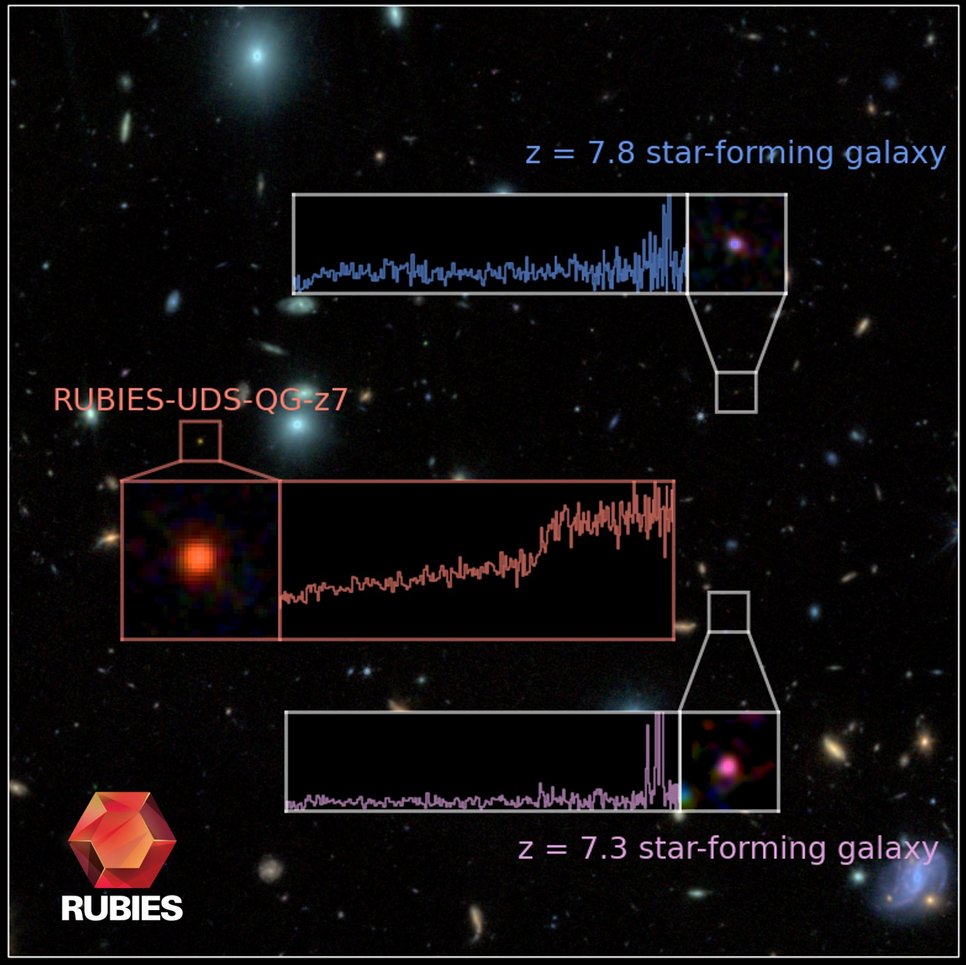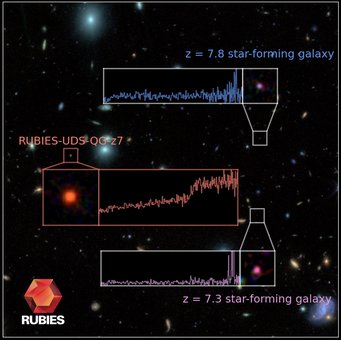ERC Starting Grant worth EUR 1.5 million for Anna de Graaff
Anna de Graaff, a researcher in Hans-Walter Rix's Galaxies and Cosmology (GC) department at the Max Planck Institute for Astronomy (MPIA) in Heidelberg, has been awarded one of the highly prestigious and well-funded grants from the European Research Council (ERC). Her project, entitled “Early Giants in Context: How could Galaxies Grow so Rapidly in the First Billion Years?”, will be funded with €1.5 million from an ERC Starting Grant starting in the summer of 2026.

Since its launch in December 2021, the James Webb Space Telescope (JWST) has already made some amazing discoveries. The telescope, to whose instrumental equipment MPIA has also made significant contributions (see here), has been able to provide observations of objects from the early days of the cosmos that may have surprised (if not alarmed) many cosmologists.
Galaxies appear to have evolved and grown surprisingly quickly in the first billion years of the universe after the Big Bang. The observations suggest that these young galaxies have a higher stellar mass than expected, already harbor very massive black holes, and in some cases have disk-shaped morphologies—thus already resembling our home galaxy, the Milky Way, in appearance.
However, according to current cosmological models and the scenarios for structure formation derived from them, such a high frequency of massive galaxies should not exist relatively close to the Big Bang. Put simply, according to current models, the time after the Big Bang would be too short for such a pace of evolution. These findings therefore pose a challenge for astrophysics, because either there is something wrong with the models or with the observations (or at least with their interpretation).
And indeed, these early JWST results are still controversial, as the properties of the objects are largely based on direct images in different filters—i.e., relatively coarse spectral (photometric) measurements which have also been interpreted using models calibrated in the local universe. In this context, "local" means using the properties of galaxies of today – i.e., galaxies that are much older than the objects observed by the JWST.
This is precisely where Anna de Graaff's newly funded project comes in:
"To answer the question of whether galaxies actually matured faster than expected, and to determine how galaxies were able to grow so quickly, a comprehensive approach is needed: high-quality spectra for a large group of massive galaxy candidates, combined with novel modeling techniques to interpret these spectra. As PI of a large JWST spectroscopic program (RUBIES), I have obtained the necessary spectra showing early massive galaxies in unprecedented detail, along with a broader 'context sample' of several thousand galaxies," says Anna de Graaff.
So, large numbers of accurate spectra are the potential key to success. Accurate spectra mean that the light from distant galaxies has been broken down into its components in much greater detail, and that the properties of these strange objects can be determined much more accurately using typical signatures, much like fingerprints.

The ERC FIRST-GIANTS project will use this new spectroscopic data set from the JWST to reliably determine the abundance of massive galaxies in the first billion years, their masses, structures, and formation history. The results will then be embedded in the context of cosmological galaxy formation models. The aim is to understand how galaxy formation took place in dark matter halos, how efficiently star formation occurred, and what regulatory mechanisms were at work.
The project could thus represent a breakthrough in our understanding of the first billion years after the Big Bang and set new standards for galaxy formation models.
The European Research Council has now allocated €1.5 million over five years to Anna de Graaff's project. The project is expected to start in the summer of 2026. The substantial funding will also make it possible to set up a working group consisting of Anna de Graaff herself (as group leader), a postdoctoral researcher, and two doctoral students.
The ERC offers various funding programs as part of its program. All applications for funding must demonstrate the excellence of the scientists involved, but above all the outstanding significance of the proposed projects.
Anna de Graaff is an expert in the field of extragalactic astronomy and is interested in the physical processes that shaped the most massive galaxies seen in our present-day Universea. She is a member of the NIRSpec GTO team and PI of the JWST Cycle 2 program RUBIES.
KJ/ADG

